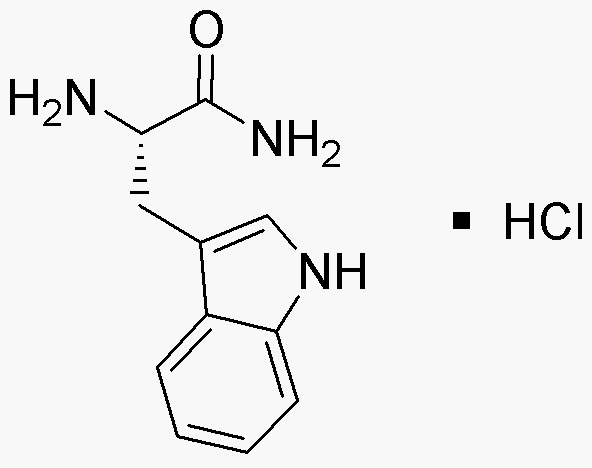L-Tryptophan amide hydrochloride is widely utilized in research focused on:
- Neuroscience Research: This compound is a precursor to serotonin, making it valuable in studies related to mood regulation and mental health disorders.
- Pharmaceutical Development: It is used in the formulation of supplements aimed at improving sleep quality and reducing anxiety, providing a natural alternative to synthetic drugs.
- Nutrition Science: As an essential amino acid, it plays a crucial role in dietary studies, particularly in understanding protein synthesis and nutritional deficiencies.
- Biochemical Studies: Researchers utilize it to investigate metabolic pathways and enzyme functions, aiding in the development of targeted therapies.
- Animal Feed Industry: It is incorporated into animal nutrition products to enhance growth and overall health, showcasing its importance in agricultural applications.
General Information
Properties
Safety and Regulations
Applications
L-Tryptophan amide hydrochloride is widely utilized in research focused on:
- Neuroscience Research: This compound is a precursor to serotonin, making it valuable in studies related to mood regulation and mental health disorders.
- Pharmaceutical Development: It is used in the formulation of supplements aimed at improving sleep quality and reducing anxiety, providing a natural alternative to synthetic drugs.
- Nutrition Science: As an essential amino acid, it plays a crucial role in dietary studies, particularly in understanding protein synthesis and nutritional deficiencies.
- Biochemical Studies: Researchers utilize it to investigate metabolic pathways and enzyme functions, aiding in the development of targeted therapies.
- Animal Feed Industry: It is incorporated into animal nutrition products to enhance growth and overall health, showcasing its importance in agricultural applications.
Documents
Safety Data Sheets (SDS)
The SDS provides comprehensive safety information on handling, storage, and disposal of the product.
Product Specification (PS)
The PS provides a comprehensive breakdown of the product’s properties, including chemical composition, physical state, purity, and storage requirements. It also details acceptable quality ranges and the product's intended applications.
Certificates of Analysis (COA)
Search for Certificates of Analysis (COA) by entering the products Lot Number. Lot and Batch Numbers can be found on a product’s label following the words ‘Lot’ or ‘Batch’.
*Catalog Number
*Lot Number
Certificates Of Origin (COO)
This COO confirms the country where the product was manufactured, and also details the materials and components used in it and whether it is derived from natural, synthetic, or other specific sources. This certificate may be required for customs, trade, and regulatory compliance.
*Catalog Number
*Lot Number
Safety Data Sheets (SDS)
The SDS provides comprehensive safety information on handling, storage, and disposal of the product.
DownloadProduct Specification (PS)
The PS provides a comprehensive breakdown of the product’s properties, including chemical composition, physical state, purity, and storage requirements. It also details acceptable quality ranges and the product's intended applications.
DownloadCertificates of Analysis (COA)
Search for Certificates of Analysis (COA) by entering the products Lot Number. Lot and Batch Numbers can be found on a product’s label following the words ‘Lot’ or ‘Batch’.
*Catalog Number
*Lot Number
Certificates Of Origin (COO)
This COO confirms the country where the product was manufactured, and also details the materials and components used in it and whether it is derived from natural, synthetic, or other specific sources. This certificate may be required for customs, trade, and regulatory compliance.


